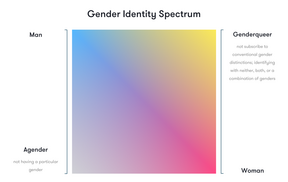Masculine of center: Difference between revisions
image |
update |
||
| Line 6: | Line 6: | ||
'''Masculine of center''' (abbreviated as MoC) is a broad [[gender expression]] term used to describe a person who identifies or presents as being more [[masculine]] than [[Femininity|feminine]]. It is most frequently used by [[lesbian]], [[queer]] or [[Non-binary gender|non-binary]] individuals {{En dash}} generally (but not exclusively) those [[assigned female at birth]]. The term was coined by B. Cole as an umbrella term to encompass several labels used by lesbian, gay, bisexual, and transgender ([[LGBT]]) people of color while describing their more-masculine gender identity. Masculine of center is most often used in communities of color, and has implicit sociocultural connotations to both gender equality and [[Anti-racism|racial justice]]. |
'''Masculine of center''' (abbreviated as MoC) is a broad [[gender expression]] term used to describe a person who identifies or presents as being more [[masculine]] than [[Femininity|feminine]]. It is most frequently used by [[lesbian]], [[queer]] or [[Non-binary gender|non-binary]] individuals {{En dash}} generally (but not exclusively) those [[assigned female at birth]]. The term was coined by B. Cole as an umbrella term to encompass several labels used by lesbian, gay, bisexual, and transgender ([[LGBT]]) people of color while describing their more-masculine gender identity. Masculine of center is most often used in communities of color, and has implicit sociocultural connotations to both gender equality and [[Anti-racism|racial justice]]. |
||
== |
== Origin == |
||
The coinage of the term masculine of center is attributed to B. Cole, a race and gender equality activist from [[Oakland, California]].<ref>{{Cite journal |last=Davis |first=Chloe O |date=2021 |title=The Blackness of Queer Vernacular. |url=https://link.gale.com/apps/doc/A674513445/AONE?u=mlin_oweb&sid=googleScholar&xid=8eacb6a4 |journal=The Gay & Lesbian Review Worldwide |publisher=The Gay & Lesbian Review Worldwide |volume=28 |issue=5 |pages=14+ |via=Gale}}</ref> Cole had identified several similar terms which [[Butch and femme|masculine-leaning]] queer people of color were using to express their gender experience (e.g. "[[Butch (lesbian slang)|butch]]," "dom," "stud," "[[two-spirit]]," "macha," etc.) Although each identity had its own respective contextual connotations, in 2010, Cole implemented the term masculine of center to "include all gender-nonconforming masculine people of color."<ref>{{Cite web |last=Bailey |first=Van |date=May 1, 2014 |title=Brown Bois |url=https://read.dukeupress.edu/tsq/article/1/1-2/45/91981/Brown-Bois |url-status=dead |archive-url=https://web.archive.org/web/20230411185028/https://read.dukeupress.edu/tsq/article/1/1-2/45/91981/Brown-Bois |archive-date=April 11, 2023 |access-date=April 14, 2023 |website=read.dukeupress.edu |doi=10.1215/23289252-2399560}}</ref> |
|||
== |
== Definition == |
||
== Usage == |
== Usage == |
||
== Sources == |
== Sources == |
||
{{Reflist}} |
|||
== External Links == |
== External Links == |
||
Revision as of 10:21, 14 April 2023

Masculine of center (abbreviated as MoC) is a broad gender expression term used to describe a person who identifies or presents as being more masculine than feminine. It is most frequently used by lesbian, queer or non-binary individuals – generally (but not exclusively) those assigned female at birth. The term was coined by B. Cole as an umbrella term to encompass several labels used by lesbian, gay, bisexual, and transgender (LGBT) people of color while describing their more-masculine gender identity. Masculine of center is most often used in communities of color, and has implicit sociocultural connotations to both gender equality and racial justice.
Origin
The coinage of the term masculine of center is attributed to B. Cole, a race and gender equality activist from Oakland, California.[1] Cole had identified several similar terms which masculine-leaning queer people of color were using to express their gender experience (e.g. "butch," "dom," "stud," "two-spirit," "macha," etc.) Although each identity had its own respective contextual connotations, in 2010, Cole implemented the term masculine of center to "include all gender-nonconforming masculine people of color."[2]
Definition
Usage
Sources
- ^ Davis, Chloe O (2021). "The Blackness of Queer Vernacular". The Gay & Lesbian Review Worldwide. 28 (5). The Gay & Lesbian Review Worldwide: 14+ – via Gale.
- ^ Bailey, Van (May 1, 2014). "Brown Bois". read.dukeupress.edu. doi:10.1215/23289252-2399560. Archived from the original on April 11, 2023. Retrieved April 14, 2023.
